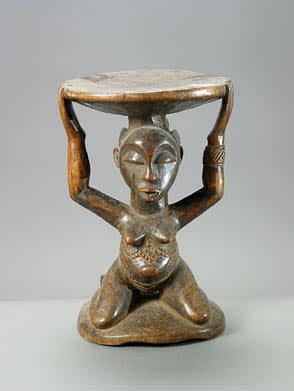Luba Wooden Caryatid Stool, 20th Century CE
Wood
11 x 16
PF.5590 (LSO)
Further images
This is an exceptional anthropomorphic – or caryatid – stool. It represents a kneeling woman with a remarkable coiffure, supporting the seat of the stool on her head, and holding...
This is an exceptional anthropomorphic – or caryatid – stool. It represents a kneeling woman with a remarkable coiffure, supporting the seat of the stool on her head, and holding it with her elongated hands. The quality of the rendering is exquisite. The face is beautifully serene, with a long, feathered coiffure reaching backwards in multi-flange form. The body is curvilinear, with evidently pregnant form and scarring on the abdomen. Other details include jewellery and geometric detailing. The piece is superbly patinated with age and wear. Stools such as this were used by chiefs and aristocrats, and was used as much to demonstrate status as to sit upon. The presence of the woman is ritual – literally being supported by one’s subjects – and aspirational, demonstrating feminine ideals.
The Luba people were once the major power in the Zairean region, with over a million people paying tribute to the descendants of King Kongolo Maniema (who founded the dynasty in 1585). They were particularly reliant upon fishing and industries such as metalworking, leading to their status as a primary node on an ever-expanding trade network that wound its way throughout West Africa and as far as the Indian Ocean. They expanded enormously during the 18th and 19th centuries, but were seriously impacted upon by slaving missions and the rise of the Ovimbudu people of Angola; they were eventually subsumed into the Belgian Congo Empire in the early 20th century.
They were governed by a combination of divine kingship and rule by council; the king (Mulopwe) ruled through a set of social notables who were collectively known as Bamfumus. These both controlled the Balopwe clan kings, who governed designated areas as symbolic sons of the king. Social harmony and memory was controlled through the Bambudye (or Mbudye) secret society, which states that all rulers of the Luba Empire traced their ancestry to Kalala Ilunga, a mystical hunter credited with toppling the cruel ruler known as Nkongolo, and inventing advanced iron forging techniques. Aristocratic status is attained by the ability to trace lineage to a founding member of the Luba people.
The Luba are renowned for their figures, as well as shrine paraphernalia such as staffs, headrests, bow stands, and royal seats. Carvers display incredible flexibility in terms of their representation techniques, some of which are so distinctive that pieces can be attributed to individual artists. They are known for Mwadi sculptures – female incarnations of ancient kings – and indeed the vast majority of known sculptures depict female rather than male figures. Women also play key roles in Luba creation myths, and are strongly associated with divination paraphernalia.
The use of stools is associated with elites in almost all African groups. This is a truly beautiful piece of African art and a credit to any collection.
The Luba people were once the major power in the Zairean region, with over a million people paying tribute to the descendants of King Kongolo Maniema (who founded the dynasty in 1585). They were particularly reliant upon fishing and industries such as metalworking, leading to their status as a primary node on an ever-expanding trade network that wound its way throughout West Africa and as far as the Indian Ocean. They expanded enormously during the 18th and 19th centuries, but were seriously impacted upon by slaving missions and the rise of the Ovimbudu people of Angola; they were eventually subsumed into the Belgian Congo Empire in the early 20th century.
They were governed by a combination of divine kingship and rule by council; the king (Mulopwe) ruled through a set of social notables who were collectively known as Bamfumus. These both controlled the Balopwe clan kings, who governed designated areas as symbolic sons of the king. Social harmony and memory was controlled through the Bambudye (or Mbudye) secret society, which states that all rulers of the Luba Empire traced their ancestry to Kalala Ilunga, a mystical hunter credited with toppling the cruel ruler known as Nkongolo, and inventing advanced iron forging techniques. Aristocratic status is attained by the ability to trace lineage to a founding member of the Luba people.
The Luba are renowned for their figures, as well as shrine paraphernalia such as staffs, headrests, bow stands, and royal seats. Carvers display incredible flexibility in terms of their representation techniques, some of which are so distinctive that pieces can be attributed to individual artists. They are known for Mwadi sculptures – female incarnations of ancient kings – and indeed the vast majority of known sculptures depict female rather than male figures. Women also play key roles in Luba creation myths, and are strongly associated with divination paraphernalia.
The use of stools is associated with elites in almost all African groups. This is a truly beautiful piece of African art and a credit to any collection.





